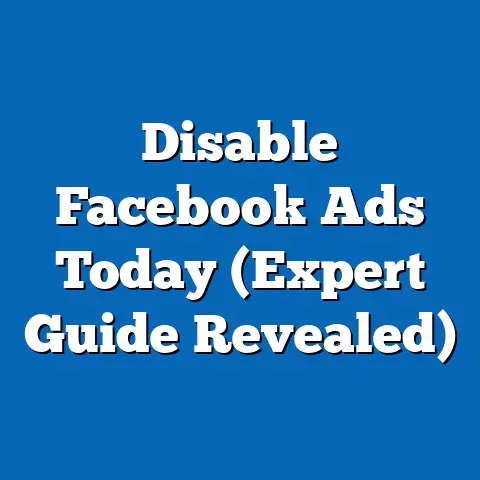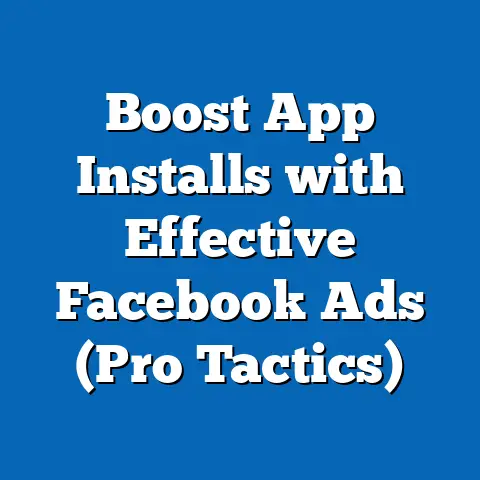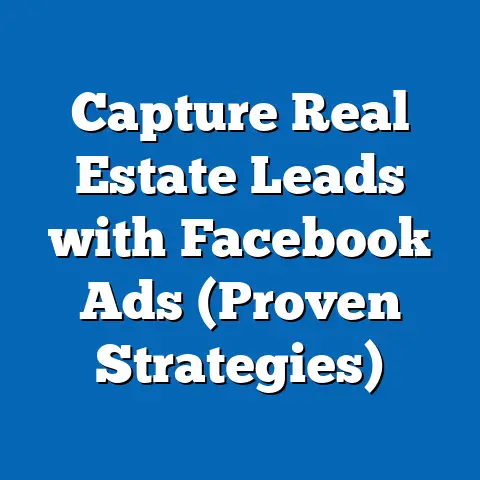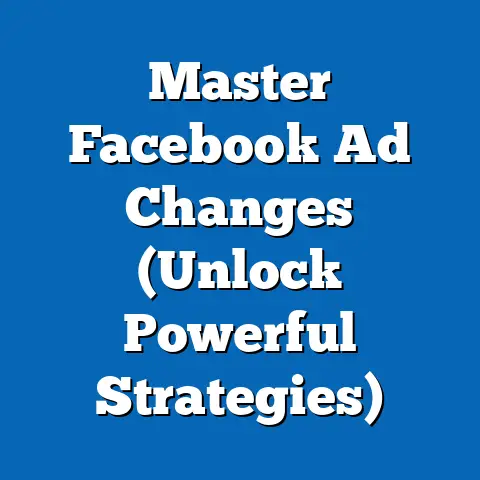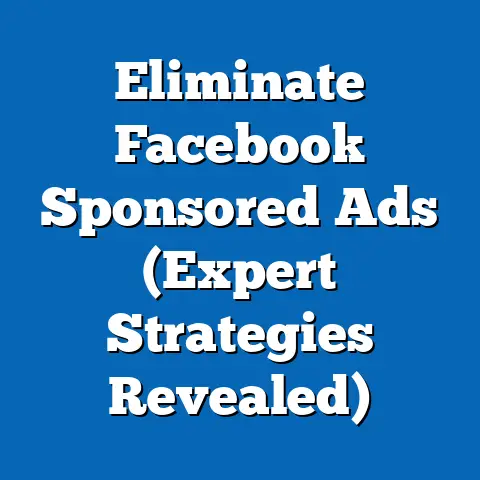Transform Browsing History into Winning Facebook Ads (Pro Tips)
Are you tired of throwing money at Facebook ads that fall flat? Do you feel like you’re shouting into the void, hoping someone, anyone, will click through and convert? You’re not alone. Many marketers today struggle to create Facebook ads that truly resonate with their target audience and drive meaningful results. We’re drowning in data – demographic data, interest data, behavioral data – but translating that information into compelling, high-converting ads feels like an impossible task. The real gold lies in understanding intent, and one of the best ways to understand intent is by analyzing browsing history.
So, how can marketers effectively leverage the browsing history of their potential customers to craft targeted Facebook ads that not only capture attention but also convert? That’s what I’m here to explore with you. I’ve spent years navigating the ever-changing landscape of Facebook advertising, and I’ve learned that the key to success isn’t just about having a big budget or a fancy creative. It’s about understanding your audience at a granular level and crafting ads that speak directly to their needs and interests. And browsing history? That’s a treasure trove of information just waiting to be unlocked.
1. Understanding Browsing History: The Digital Fingerprint
What exactly do I mean by “browsing history”? It’s more than just a list of websites someone has visited. It’s a digital fingerprint that reveals a user’s interests, preferences, behaviors, and even their pain points. Think of it as a real-time diary of their online activity.
Browsing history includes:
- Websites visited: From news sites to online stores, every website a user visits leaves a trace.
- Search queries: What are they searching for on Google, Bing, or other search engines? This reveals their immediate needs and interests.
- Products viewed: What products are they browsing on e-commerce sites? This indicates their potential purchase intent.
- Articles read: What topics are they interested in learning more about? This provides insights into their values and beliefs.
- Videos watched: What kind of video content do they consume? This can reveal their hobbies, interests, and entertainment preferences.
- Forms filled out: Did they download a whitepaper? Sign up for a newsletter? This indicates a higher level of engagement and interest.
Understanding customer journeys is paramount, and browsing history provides invaluable insights into this journey. By analyzing the websites and content a user interacts with, we can piece together a picture of their needs, motivations, and pain points at different stages of the buying process. Are they researching solutions to a problem? Are they comparing different products? Are they ready to make a purchase? Browsing history can help us answer these questions and tailor our ads accordingly.
Why is this important? Because personalized ads are more effective. Research consistently shows a strong correlation between personalized ads based on browsing history and improved ad performance. For example, a study by Experian found that personalized emails based on browsing behavior had six times higher transaction rates than generic emails. While this data is for email, the principle directly translates to Facebook Ads. It’s about relevance.
Takeaway: Browsing history is a goldmine of information that reveals user intent and preferences. By understanding your audience’s online behavior, you can create more targeted and effective Facebook ads.
2. Data Collection and Privacy Considerations: Walking the Ethical Tightrope
Now, let’s talk about the elephant in the room: data collection and privacy. Collecting browsing data isn’t as simple as flipping a switch. It requires careful planning, ethical considerations, and a deep understanding of privacy regulations.
There are several methods for collecting browsing data:
- Cookies: Small text files that websites store on a user’s computer to track their activity.
- Tracking pixels: Tiny snippets of code embedded in websites or emails that track user behavior.
- User surveys: Direct feedback from users about their interests and preferences.
- Third-party data providers: Companies that collect and sell browsing data from various sources.
However, with great data comes great responsibility. We need to be mindful of the ethical implications and privacy considerations of using browsing history for ad targeting. Regulations like GDPR (General Data Protection Regulation) in Europe and CCPA (California Consumer Privacy Act) in the US have set strict rules about how personal data can be collected, used, and stored.
Here are some key principles to keep in mind:
- Transparency: Be upfront with users about how you’re collecting and using their data.
- Consent: Obtain explicit consent from users before tracking their browsing behavior.
- Data minimization: Only collect the data you need for your specific advertising purposes.
- Security: Protect user data from unauthorized access or breaches.
- Compliance: Stay up-to-date with the latest privacy regulations and ensure your practices are compliant.
Building trust with your customers is crucial. If they feel like you’re being sneaky or intrusive, they’re less likely to engage with your ads and more likely to block your tracking efforts. Be transparent, be respectful, and prioritize their privacy.
Takeaway: Collecting and using browsing data requires careful consideration of ethical and privacy implications. Transparency, consent, and compliance with regulations are essential for building trust with your customers.
3. Analyzing Browsing History for Insights: Unveiling the Patterns
Once you’ve collected browsing data, the real work begins: analyzing it to extract meaningful insights. This is where the magic happens. By identifying patterns and trends in user behavior, you can uncover hidden opportunities and create highly targeted ad campaigns.
There are several tools and analytics software that can help you interpret browsing data:
- Google Analytics: A powerful web analytics platform that tracks website traffic, user behavior, and conversions.
- Facebook Insights: Provides data on the performance of your Facebook ads and the demographics and interests of your audience.
- CRM platforms: Customer Relationship Management systems like Salesforce or HubSpot can integrate with your website and track user activity, providing a comprehensive view of the customer journey.
- Data management platforms (DMPs): Specialized platforms that collect, organize, and analyze large volumes of data from various sources.
Here are some examples of how you can segment audiences based on browsing behavior:
- Interests: Users who frequently visit websites related to cooking, travel, or sports can be targeted with ads for relevant products or services.
- Pages visited: Users who have visited specific product pages on your website can be retargeted with ads featuring those products.
- Time spent on site: Users who spend a significant amount of time on your website may be more engaged and receptive to your ads.
- Search queries: Users who have searched for specific keywords related to your products or services can be targeted with ads that address their specific needs.
- Content consumption: Users who have read specific articles or watched specific videos can be targeted with ads that align with their interests.
For example, let’s say you’re selling hiking boots. You could segment your audience based on:
- Users who have visited hiking trails websites.
- Users who have searched for “best hiking boots” on Google.
- Users who have watched videos about hiking gear.
- Users who have visited your website and viewed specific hiking boot models.
By understanding these nuances, I can craft more compelling and relevant Facebook ads.
Takeaway: Analyzing browsing history allows you to identify patterns and trends in user behavior, enabling you to segment your audience and create highly targeted ad campaigns.
4. Crafting Targeted Facebook Ads: Speaking Their Language
Now comes the fun part: translating those insights into effective ad copy and creative. This is where you get to put your understanding of your audience to the test.
Personalization is key. Generic ads that appeal to everyone appeal to no one. Your ads should speak directly to the needs, interests, and pain points of your target audience segments.
Here are some tips on crafting personalized ad copy:
- Use their language: Use the same words and phrases that your target audience uses when talking about your products or services.
- Address their pain points: Acknowledge the challenges and frustrations that your target audience faces and explain how your product or service can help.
- Highlight the benefits: Focus on the specific benefits that your target audience will receive from using your product or service.
- Use social proof: Include testimonials, reviews, or case studies to build trust and credibility.
Dynamic ads are a powerful way to personalize your ad messaging based on users’ past interactions. For example, if a user has viewed a specific product on your website, you can show them an ad featuring that product with a personalized message like, “Still thinking about this? Get it now!”
Selecting the right images, headlines, and calls-to-action is crucial for capturing attention and driving clicks. Your visuals should be relevant to your target audience and visually appealing. Your headlines should be attention-grabbing and clearly communicate the value proposition of your ad. Your calls-to-action should be clear, concise, and encourage users to take the next step.
Takeaway: Translate insights from browsing history into personalized ad copy and creative that resonates with your target audience. Use dynamic ads to reflect users’ past interactions and select visuals, headlines, and calls-to-action that capture attention and drive clicks.
5. Retargeting Strategies: Bringing Them Back
Retargeting is one of the most effective ways to use browsing history to boost your Facebook ad performance. It involves showing ads to users who have previously interacted with your website or app.
Think about it: these users are already familiar with your brand and products, so they’re more likely to convert. Retargeting allows you to re-engage these users and guide them further down the sales funnel.
Setting up retargeting campaigns on Facebook is relatively straightforward. You can create custom audiences based on website visitors, app users, or users who have interacted with your Facebook page.
Timing and frequency are crucial in retargeting. You don’t want to bombard users with too many ads, but you also don’t want to let them forget about you. Experiment with different ad frequencies and time windows to find the optimal balance.
Here are some advanced retargeting strategies:
- Sequential retargeting: Show users a series of ads that guide them through the buyer’s journey, starting with awareness and ending with conversion.
- Cross-selling and upselling: Show users ads for related products or services that complement their previous purchases.
- Abandoned cart retargeting: Show users ads for products they left in their shopping cart, reminding them to complete their purchase.
I once ran a retargeting campaign for a client who sold online courses. We segmented our audience based on the courses they had viewed and showed them personalized ads with testimonials and special offers. This campaign resulted in a 30% increase in course enrollments.
Takeaway: Retargeting is a powerful way to re-engage users who have previously interacted with your website or app. Use advanced retargeting strategies like sequential retargeting to guide users through the buyer’s journey and boost conversions.
6. A/B Testing and Optimization: The Path to Perfection
No Facebook ad campaign is perfect right out of the gate. A/B testing is essential for fine-tuning your ads and maximizing their performance.
A/B testing involves creating two or more variations of your ad and showing them to different segments of your audience. By comparing the performance of each variation, you can identify which elements are most effective and optimize your ads accordingly.
Here’s a step-by-step guide on how to set up A/B tests for your Facebook ads:
- Identify a variable to test: This could be the headline, image, call-to-action, or targeting options.
- Create two or more variations of your ad: Change only one variable at a time to isolate the impact of that variable.
- Set up your A/B test in Facebook Ads Manager: Use the “Split Test” feature to create your variations and allocate your budget.
- Run your test for a sufficient amount of time: Allow enough time for each variation to reach a statistically significant sample size.
- Analyze the results: Identify which variation performed best based on your key performance indicators (KPIs).
- Implement the winning variation: Update your ad campaign with the winning elements and continue testing other variables.
Key performance indicators (KPIs) to monitor for assessing the effectiveness of your ads include:
- Click-through rate (CTR): The percentage of users who click on your ad.
- Conversion rate: The percentage of users who complete a desired action, such as making a purchase or filling out a form.
- Cost per click (CPC): The average cost you pay for each click on your ad.
- Cost per acquisition (CPA): The average cost you pay for each conversion.
- Return on ad spend (ROAS): The amount of revenue you generate for every dollar you spend on advertising.
Takeaway: A/B testing is essential for fine-tuning your Facebook ads and maximizing their performance. Monitor key performance indicators (KPIs) to assess the effectiveness of your ads and adjust your campaigns accordingly.
7. Case Studies and Success Stories: Learning from the Best
Let’s take a look at some real-life examples of brands that have successfully transformed browsing history into winning Facebook ads. These case studies can provide inspiration and practical insights for your own campaigns.
-
Example 1: E-commerce Brand Using Abandoned Cart Retargeting: An online clothing retailer tracked users who added items to their cart but didn’t complete the purchase. They then retargeted these users with ads featuring the abandoned items and a special discount. This resulted in a 20% increase in recovered sales.
-
Example 2: Travel Company Personalizing Ad Copy: A travel agency analyzed the websites visited by their users and segmented them based on their travel interests (e.g., adventure travel, luxury travel, family travel). They then created personalized ad copy that highlighted the specific benefits of their travel packages for each segment. This resulted in a 15% increase in click-through rates.
-
Example 3: Software Company Using Sequential Retargeting: A software company created a series of ads that guided users through the buyer’s journey, starting with awareness (explaining the problem their software solves), moving to consideration (showcasing the features and benefits of their software), and ending with conversion (offering a free trial or demo). This resulted in a 25% increase in trial sign-ups.
Example 1: E-commerce Brand Using Abandoned Cart Retargeting: An online clothing retailer tracked users who added items to their cart but didn’t complete the purchase. They then retargeted these users with ads featuring the abandoned items and a special discount. This resulted in a 20% increase in recovered sales.
Example 2: Travel Company Personalizing Ad Copy: A travel agency analyzed the websites visited by their users and segmented them based on their travel interests (e.g., adventure travel, luxury travel, family travel). They then created personalized ad copy that highlighted the specific benefits of their travel packages for each segment. This resulted in a 15% increase in click-through rates.
Example 3: Software Company Using Sequential Retargeting: A software company created a series of ads that guided users through the buyer’s journey, starting with awareness (explaining the problem their software solves), moving to consideration (showcasing the features and benefits of their software), and ending with conversion (offering a free trial or demo). This resulted in a 25% increase in trial sign-ups.
These examples demonstrate the power of leveraging browsing history to create more personalized, relevant, and high-performing Facebook ads.
Takeaway: Learn from successful brands that have transformed browsing history into winning Facebook ads. Analyze their strategies and draw inspiration for your own campaigns.
Conclusion: The Future of Facebook Advertising is Personal
The landscape of digital advertising is constantly evolving. As consumers become more sophisticated and ad-blindness increases, the need for personalized, relevant, and engaging ads is greater than ever.
By effectively leveraging browsing history, marketers can create Facebook ads that resonate with their target audience, drive conversions, and build stronger customer relationships. It’s not just about showing ads; it’s about delivering value and creating meaningful connections.
The future of Facebook advertising is personal. Embrace these pro tips, experiment with your own campaigns, and stay ahead in the competitive landscape.
Call to Action:
Start implementing these strategies today! Analyze your audience’s browsing history, craft personalized ad copy, and launch retargeting campaigns that convert. Share your experiences and results in the comments or through social media. Let’s learn and grow together!

